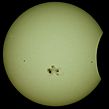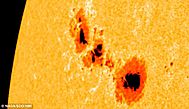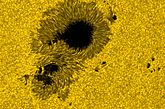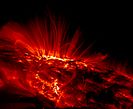Sunspot facts for kids
|
||||
|
||||
A sunspot is a dark, cool area on the Sun's surface. These spots look dark because they are cooler than the areas around them. They are still very hot, but not as bright. Sunspots have strong magnetic activity. Some sunspots are small, while others can be ten times bigger than Earth!
The number of sunspots changes over time. This change follows a pattern called the sunspot cycle. This cycle usually lasts about eleven years. During this time, the number of sunspots goes up and then comes back down. Scientists have seen this cycle since the 1700s.
Contents
What Are Sunspots?
Sunspots are like temporary dark patches on the Sun. They form when strong magnetic fields stop heat from reaching the Sun's surface. This makes the sunspot cooler than the rest of the Sun. Even though they are cooler, sunspots are still very hot. Their temperature is about 7,000 degrees Fahrenheit (4,000 degrees Celsius). The rest of the Sun's surface is much hotter.
The Sunspot Cycle Explained
The sunspot cycle is a regular pattern of how many sunspots appear. Every 11 years, the number of sunspots increases. Then, it slowly goes down again. This is called the solar maximum (most sunspots) and solar minimum (fewest sunspots).
Interestingly, the magnetic fields of sunspots flip direction every 11 years. This means a full magnetic cycle takes 22 years. Scientists have been watching these cycles for a long time.
There was a period from the mid-1600s to the early 1700s when very few sunspots appeared. This time is known as the "Maunder Minimum." Astronomers are still trying to understand why this happened.
How We Discovered Sunspots
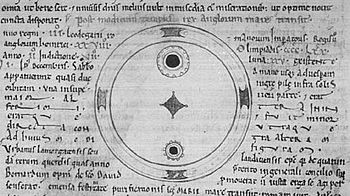
People in ancient China were among the first to notice sunspots. They wrote about seeing dark spots on the Sun. In 802 AD, a monk named Adelmus also saw a large sunspot. He thought it was the planet Mercury passing in front of the Sun.
However, people didn't truly understand what sunspots were until Galileo Galilei studied them in 1612. Sunspots helped scientists realize that the Sun actually rotates. They could see the spots move across the Sun's surface.
Later, in 1843, Heinrich Schwabe noticed the regular, cyclic changes in sunspots. This led Rudolf Wolf to start carefully studying them in 1848. Also in 1848, Joseph Henry showed that sunspots were indeed cooler than the rest of the Sun.
How Sunspots Affect Earth
Sunspots can have an impact on our planet, Earth. Even though sunspots are cooler, a lot of sunspots usually means the Sun is more active overall. This increased activity can make the Sun slightly hotter.
This change in the Sun's activity can affect Earth's weather. It can also impact things like radio reception. If there were no sunspots, Earth might be cooler. On the other hand, too many sunspots could make Earth warmer and lead to less rain. Less rain can cause droughts.
Droughts are long periods with no rain. When there's a drought, plants can't grow, and animals struggle to find food and water. People also need rain for their food and water supply. So, sunspots play a role in keeping Earth's temperature just right for life. Scientists continue to study sunspots to understand their full effects on our planet.
Images for kids
-
ALMA observes a giant sunspot at 1.25 mm wavelength
-
Sunset superior mirage of sunspot #930.
-
Tracking sunspots from Mars (animation; 8 July 2015).
See also
 In Spanish: Mancha solar para niños
In Spanish: Mancha solar para niños


